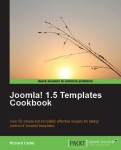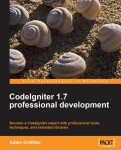When you look for a WordPress theme design books, there isn’t much choice. I looked at the country’s best book store and found nine books when I search for “WordPress themes”. Five of them are published by Packt Publishing. Some of these books only feature a chapter about WordPress theme design or studies, only some are actually interesting.
Packt Publishing offered me the chance to review “WordPress 2.8 Themes Cookbook”. And that’s what you’re reading right now!
A little about me:
I am Ramon “Ramoonus” van Belzen. A 22 year old webdesigner (HTML, CSS, microformats, Javascript, AJAX, jQuery, PHP/MySQL) and hobby programmer (Visual Basic) with over 10 different WordPress installations online. I`ve been creating webpages since 1997.
The WordPress 2.8 themes design cookbook is one of Packt Publishings cookbook series meaning it contains loads of recipes. Each recipe is a small articles/paragraphs with an idea and how to work it out. Just like a regular cookbook. I haven’t got compression material to compare the book with others of the same topic.
The book is called “WordPress 2.8 themes design cookbook”, which means it’s all about WordPress 2.9 theme designing. After reading the book you should be able to create and modify WordPress themes.
I bet you’re wondering if it’s outdated already since the release of WordPress 3.0? No it’s not. The book is actually until WordPress 2.9 and it should remain usable for the next several point releases. It contains the use of all implemented theme design features in WordPress 2.8.
For the book you will need to have prior knowledge of WordPress (how to use it) and experience with HTML, CSS and basic PHP knowledge. The PHP knowledge isn’t required but trustsme, it’s useful when it comes to debugging typos. Experience with Javascript and frameworks like jQuery is handy but not required. There is no knowledge of WordPress theme design needed.
The first chapter takes you through the basics of WordPress themes and mentions how to use some basic strings you’ll need in every template. It also describes how to make your first theme style.css, how to make a child template and how WordPress template files are organised.
The second chapter helps you create a navigation menu in several ways (horizontally and vertically) and tells you how to implement a search area in your template.
Chapter three explains “the loop”. The loop is the part where a page or post(s) show up. There are multiple ways of displaying the page content for category or tag archives and the homepage. It’s also possible to style sticky pages differently. Finally the chapter explains how to implement advertisement between posts.
The next chapter explains how to implement template tags like an edit button, previous/next link, using an excerpt and such. One of the most handy things is probably a search highlighters. No more use of third party plugins which break down too often!
The fifth chapter explains how to implement WordPress commenting features in your template.
Chapter six is also an important one (isn’t every chapter?!) since it explains how to work with sidebars. Sidebars can contains widgets by default or manually. The chapter also explains how to use multiple sidebars and pre-install widgets.
Chapter seven explains how to use custom page templates like a photo album or archive page.
The following chapter (eight) explains how to use CSS and PHP to style images in the theme. It ends with implementing video`s in pages and posts.
Next chapter guides you through author pages and adding custom user fields (like a Twitter field). Creating a custom author page gives the author its own short page about himself.
Chapter ten is one of those you’ll probably need when your theme is nearly finished. Its about adding JavaScript effects to the theme. It also guides you through a simple installation of already in WordPress implemented JavaScript libraries like prototype, scriptalulous and jQuery (UI). This is followed by a JavaScript post slider (skinable), toggle-able widgets and a font-size toggle. Handy functions for every theme!
Template eleven is called Advanced WordPress Themes. It explains how to use a theme options page, use multiple color schemes, create a default theme avatar, how-to localize the theme, implementing your own shortcodes and information on publishing the theme to wordpress.org
The final chapter (twelve) contains more advanced features like a rotating header image, centring the main content, making draggable items, creating a tabbed navigation and adding a global toolbar to the theme.
I’m glad I got this book. After reading this book (in just a couple of hours – which is good) I can say to people I can design, create and modify WordPress themes.
The images included really show you what’s the point of what you’ve done and are a good addition to the text.
If you’re looking for a book about WordPress theme design to get started with modifying and/or creating themes, this is the one you should consider buying.
The book should be available at all good book stores right now. You can also order it online (on paper or as E-Books) at https://www.packtpub.com/wordpress-2-8-themes-cookbook/book. This is also the link for more information. A sample chapter (chapter 3 – the loop) can be found at https://www.packtpub.com/sites/default/files/8440-chapter-3-the-loop.pdf
Review by Ramon “Ramoonus” van Belzen
Written by Lee Jordan & Nick Ohrn
Book published in July 2010, by Packt Publishing (Open Source). 296 pages. Paperback
ISBN13: 9781847198440

